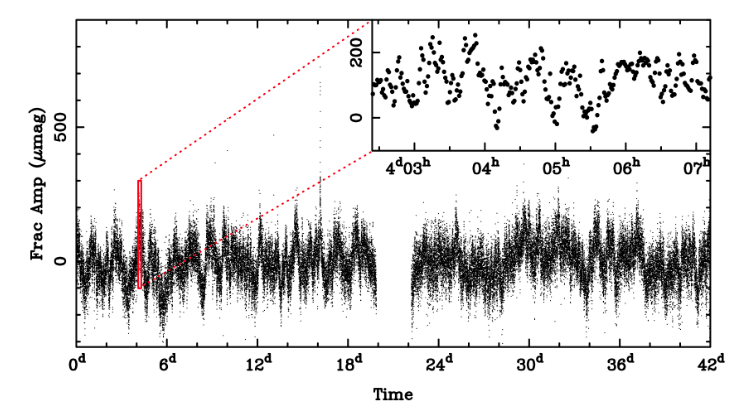|
|
|
||

| |||
| Kepler Public Data | |
| +Kepler Data Archive | |
|
PUBLIC DATA FOR θ CYGNI RELEASED |
Observing Period: June - September 2010 |

|
|
|
A 42 day segment of the Quarter 6 short cadence light curve for θ Cygni. The inset shows ~5 hours of data at finer temporal resolution. The data were normalized to the mean flux within the displayed time period. |
|
|
During Quarter 6 the Guest Observer Office targeted the bright star θ Cyg (KIC 11918630), the brightest star located on active pixels within the Kepler field. The GO Office observed this source to develop and refine procedures for constructing dedicated pixel masks for highly-saturated targets. We note that this is a service available to the community through the Director's Discretionary Program.
Download the θ Cygni short cadence light curve here.
Details about this observation were presented at the Seattle meeting of the American Astronomical Society as presentation 140.07. This presentation can be downloaded here. The abstract is given below: Public Kepler Data on the Bright Star θ Cygni The bright star θ Cygni (Kepler ID 11918630) has been observed by Kepler in both short (59 sec) and long (29.4 min) cadence for a period of approximately 50 days starting on MJD 55410. These observations were made at the request of the Kepler Guest Observer Office and are intended for immediate public release. The purpose is to demonstrate Keplers exquisite photometric precision on bright, highly saturated targets. Theta Cygni is a F3V/M3V binary with a visual magnitude of 4.9/13.0. The short-cadence data show evidence of granulation (i.e., convection) out to about 1 mHz (~100 c/d) and clear detection of numerous p-modes with a peak near 1.8 mHz (~150 c/d). The high-frequency noise floor has a 3-sigma upper envelope of 0.4 ppm. The amplitude of the p-modes agrees with the stellar effective temperature, indicating that the star has a thin convective layer. Since a custom aperture was employed, the light curves will be constructed manually and placed on the Guest Observer website (http://keplergo.arc.nasa.gov/). The corresponding pixel-level data will be available from the Kepler archive (http://archive.stsci.edu/kepler/). The Kepler mission can accommodate a small number of such bright targets every quarter. Observing proposals can be submitted annually to the peer-reviewed Guest Observer Program, or much less formally on a quarterly basis for Directors Discretionary Time. Kepler was selected as the 10th mission of the Discovery Program. Funding for this mission is provided by NASA, Science Mission Directorate. Please direct questions about this data to the . | |
|
QUICK LINKS
|
|
Questions concerning Kepler's science opportunities and open programs, public archive or community tools? Contact us via the email address.